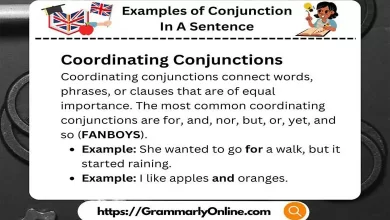Coordinating Conjunction Examples
In the realm of English grammar, coordinating conjunctions play a pivotal role in creating coherence and flow within sentences. These small but mighty words—and, but, or, nor, for, so, and yet—serve as the glue that binds ideas together, ensuring clarity and readability. In this comprehensive guide, we delve into the intricacies of coordinating conjunctions, providing extensive examples and detailed explanations to enhance your understanding and usage of these essential components of writing.
Understanding Coordinating Conjunctions
Definition and Function
Coordinating conjunctions are used to connect words, phrases, or clauses that are of equal grammatical rank. They help in constructing compound sentences, which combine two or more independent clauses into a single, cohesive thought. By doing so, they aid in the seamless flow of ideas, making writing more engaging and easier to follow.
The Seven Coordinating Conjunctions
The seven coordinating conjunctions can be easily remembered using the acronym FANBOYS:
- For
- And
- Nor
- But
- Or
- Yet
- So
Examples of Coordinating Conjunctions in Sentences
1. And
The conjunction and is used to add information or ideas together.
Examples:
- She bought apples, oranges, and bananas.
- He wanted to study law, and she preferred medicine.
- The dog barked loudly, and the cat hissed in response.
2. But
But is used to introduce a contrast or exception.
Examples:
- I wanted to go for a walk, but it started raining.
- She is kind, but he is rude.
- He tried his best, but he couldn’t win the race.
3. Or
Or presents alternatives or choices.
Examples:
- Do you prefer tea or coffee?
- You can stay here, or you can come with us.
- Should we watch a movie or go out for dinner?
4. Nor
Nor is used to connect two negative alternatives.
Examples:
- He didn’t call, nor did he send a message.
- She has never traveled to Europe, nor does she want to.
- They don’t like broccoli, nor do they enjoy spinach.
5. For
For is used to explain reasons or purposes.
Examples:
- He was tired, for he had worked all day.
- She didn’t join the meeting, for she was feeling unwell.
- They decided to leave early, for they wanted to avoid traffic.
6. Yet
Yet introduces a contrast or an unexpected outcome.
Examples:
- She is very young, yet she is exceptionally talented.
- He has little experience, yet he got the job.
- The project was challenging, yet they completed it on time.
7. So
So indicates a result or consequence.
Examples:
- It was late, so they decided to go home.
- She studied hard, so she passed the exam with flying colors.
- He missed the bus, so he had to walk to work.
Compound Sentences with Coordinating Conjunctions
Creating Compound Sentences
Compound sentences are formed by joining two independent clauses with a coordinating conjunction. Each clause in a compound sentence can stand alone as a complete sentence, but when combined, they provide a more complex and nuanced thought.
Examples:
- She wanted to play the piano, but she didn’t have time to practice.
- The weather was perfect, so we went for a hike.
- He could choose to stay home, or he could go out with his friends.
Punctuation with Coordinating Conjunctions
When forming compound sentences with coordinating conjunctions, a comma is typically placed before the conjunction to separate the independent clauses.
Examples:
- I wanted to buy a new car, but I didn’t have enough money.
- He studied for the exam, and he passed with top marks.
- She loves to read books, so she spends a lot of time in the library.
Avoiding Common Mistakes
Comma Splices
A comma splice occurs when two independent clauses are joined with just a comma and no coordinating conjunction. This is incorrect and can be fixed by adding the appropriate conjunction or changing the punctuation.
Incorrect:
- She loves to dance, she practices every day.
Correct:
- She loves to dance, so she practices every day.
Run-on Sentences
A run-on sentence happens when two or more independent clauses are joined without any punctuation or coordinating conjunctions. This can be corrected by adding the necessary punctuation and conjunctions.
Incorrect:
- He wanted to go to the park he couldn’t find his keys.
Correct:
- He wanted to go to the park, but he couldn’t find his keys.
Effective Use of Coordinating Conjunctions in Writing
Enhancing Clarity and Coherence
Using coordinating conjunctions effectively can greatly enhance the clarity and coherence of your writing. They help to logically connect ideas, making your arguments more persuasive and your narratives more engaging.
Examples in Professional Writing
In Essays:
- Coordinating conjunctions are essential in crafting compelling arguments and providing clear reasoning.
Example:
- “The policy has several benefits, but it also has some drawbacks.”
In Reports:
- They help in presenting data and findings in a coherent manner.
Example:
- “The sales figures increased, and the profit margins improved.”
In Creative Writing:
- They contribute to the flow of the story and the development of characters.
Example:
- “She was scared, yet she stepped forward bravely.”
Conclusion
Coordinating conjunctions are fundamental elements in English grammar that contribute significantly to the construction of clear, coherent, and engaging sentences. By mastering the use of these conjunctions, writers can effectively connect ideas, present contrasts, offer alternatives, and explain reasons, all while enhancing the readability and flow of their writing. Whether you are crafting academic essays, professional reports, or creative stories, the strategic use of coordinating conjunctions will elevate the quality of your work and ensure that your message is conveyed with precision and clarity.

